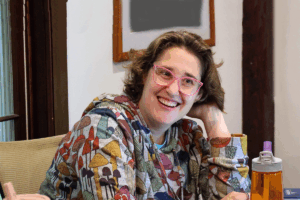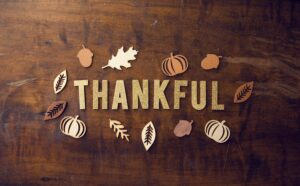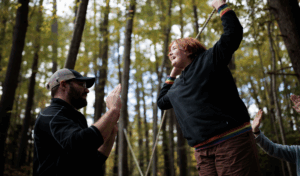It is widely recognized that grief and loss can be accompanied by a wide range of emotional experiences. Among the most commonly reported are anxiety and fear. In addition to the growing body of research on the interplay between grief and anxiety, one author, Claire Bidwell Smith, LCPC, brought specific attention to this phenomenon in her 2018 book Anxiety: The Missing Stage of Grief.
Despite our understanding of the complex relationship between anxiety, fear, and grief, the experience often remains overwhelming and deeply debilitating. Yet within our deepest fears and most profound losses lies an invitation: to discover new ways of living fully, to connect more deeply, and to transform pain into purpose.
Myra Sack was recently featured on the Fear Less podcast, where she shared her story of confronting fear while navigating the devastating loss of her infant child, Javi, to Tay-Sachs disease. Since Javi’s passing, Myra has founded the nonprofit organization E-Motion, which centers its work on three pillars of healing: movement, ritual, and community. The following article explores some of the wisdom Myra shared during the episode.
From Joy to Terror: The Arc of Fear and Anxiety
“The first time fear showed up was in stark contrast to the awe and beauty and joy when Javi was first born… What if we as parents aren’t enough?”
When Myra and her husband welcomed Javi into the world, fear and anxiety lurked beneath the joy of new parenthood. Like many, their “future-oriented mindset” brought with it quiet questions: Will I be enough? What if something goes wrong? Initially, this was anxiety—an uncertain anticipation of danger not yet realized.
At 15 months, Javi began missing developmental milestones. Myra remembers “the tightness of my chest… the heaviness of my legs”—somatic echoes of fear emerging with every missed crawl or unsteady step. Then came the crushing diagnosis: a physician’s testing error revealed that Javi had Tay-Sachs, a life-limiting neurodegenerative disease. Fear became terror as they confronted an ending they “knew was the worst one possible.”
Even in the darkest moments, Myra found a crucial insight:
“That fear… is outside of us. It’s not us. And we can engage with it.”
By choosing to engage with their fear—rather than resist it—Myra and her husband were able to live with presence, love, and purpose.
Pillar One: Movement—Harnessing the Rhythm of Healing
“Patterned, repetitive, rhythmic activity… is the strongest somatosensory memory that we have.”
For Myra, movement was not merely exercise but a regulated, embodied way to process trauma. Inspired by the work of Dr. Bruce Perry, she discovered that walking, running, and swaying tap into a deep-seated rhythm—one tied to our earliest days, listening to a mother’s heartbeat.
-
Presence in motion: Rather than mentally rehearsing to-do lists, Myra began noticing purple flowers on her runs—Javi’s favorite color—turning each outing into a mindful act of remembrance.
-
Dosed exposure: In E-Motion’s 10-week cohorts, participants alternate between gentle rituals and communal movement, providing a “moderate and predictable” encounter with grief rather than a single, overwhelming outpouring.
Both concepts align closely with our work at Mountain Valley. Rhythmic, repetitive movement is a powerful tool for regulating an anxious nervous system, and our Occupational Therapists incorporate these sensory strategies into each resident’s care. The idea of “dosed exposure” also mirrors the gradual exposure approach we take when helping residents face their fears—whether rooted in trauma, loss, or phobia. Safely “dosing” into what feels difficult helps build resilience rather than reinforce avoidance.
Pillar Two: Ritual—Anchors in Chaos
“Ritual is the antidote to helplessness.” —Suki Miller
When Javi could no longer chew her favorite blueberries, Myra and Matt adapted: first pancakes, then smoothies. After Javi’s passing, making a vibrant blueberry smoothie became Myra’s micro-ritual—a daily, dosed reminder of her daughter’s life and love.
Rituals:
-
Create predictability in an unpredictable world
-
Provide a container for feeling—whether sacred or painful—in a manageable way
-
Empower agency in times of helplessness
For anyone navigating anxiety—whether in preparation for an exam or in the wake of a loss—personal rituals such as morning breathing, weekly journaling, or lighting a candle can provide grounding and rhythm.
That said, we must use rituals wisely. In anxiety disorders and related conditions like OCD, rituals can sometimes evolve into compulsions that begin to run one’s life. The use of ritual to foster emotional healing is ancient, intuitive, and powerful—but it must be approached with mindfulness and intention.
Pillar Three: Community—Bearing Pain Together
“We need other people to hold our pain and our love… we can’t do it in isolation.”
Grief and anxiety often thrive in isolation. Myra found healing not in solitude, but in communal spaces—especially those with near-peer support, where vulnerability fosters connection. In E-Motion’s movement groups:
-
Participants name their loved one aloud, sway together, then walk and talk
-
They share “psychological Teflon”—the experience of being seen, believed, and remembered
This practice isn’t limited to bereavement. For those with anxiety or OCD, community—whether in a therapy group, classroom, or faith circle—can provide the same life-sustaining support. Rather than compare our pain in the “Lost Olympics,” we can affirm: Your fear matters. Your grief matters. We’re here. That ethos is central to our approach at Mountain Valley.
Moving Forward: Love Bigger Than Fear
Myra and Matt chose to grow their family, welcoming a second daughter, Kaia. Even while awaiting prenatal test results with anxiety, they practiced noticing “future-telling stories” and returning gently to the present moment.
They came to believe that love, even with all its risks, was worth it:
“The love can be bigger than the fear… the risk of losing again is worth it, because the possibility of loving big is more motivating.”
A Call to Practice
Whether you’re wrestling with anticipation or mourning a loss, consider these gentle invitations:
-
How can I move with purpose today? Notice your breath, your steps, your surroundings.
-
What simple ritual could anchor me? Choose a recurring act—a candle, a cup of tea—that holds meaning.
-
Who can walk beside me? Reach out to someone who will listen, witness, and remember with you.
When we choose to meet fear and grief—rather than fight or flee—we often uncover unexpected reservoirs of clarity, compassion, and strength. As Myra’s story shows, these practices don’t erase pain, but they offer a way to live fully through it.
🎧 Listen to the full conversation with Myra Sack on the Fear Less podcast: Embracing Fear and Grief


